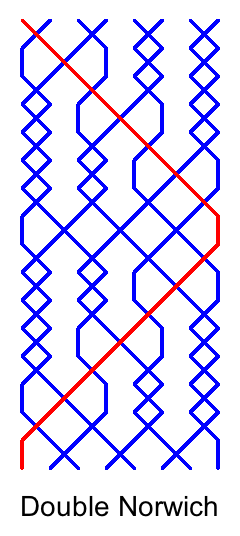First item: we rang a quarter of London yesterday, with Angela on the tenors instead of the trebles. It took us a few attempts to get this one (but I must confess that last week's attempt was going really well until I skipped a lead and systematically put everyone else wrong). Jonathan called it from 5-6, with a not particularly handbell-specific composition, which was a good achievement.

After that, we rang a course of Double Norwich with the specific idea of thinking about how we rang it. In the tower, it's not rung as much as Surprise Major, but everyone seems to have the idea that Surprise Major ringers should be able to ring it. There are several approaches. One is to simply treat it like any other method, and learn the line by place bells. Another is to ring it by where you pass the treble: double dodge at the front and back unless the treble is there; move from a double dodge to far places or from no dodge to near places. Yet another is to rely on a half-remembered mnemonic: near, full, far, first, treble bob, last. This usually requires some discussion of what the mnemonic means.
A few years ago we rang a peal of Double Norwich in the tower at Glasgow, and while practising for it, it seemed that the ringers relying on structure and mnemonics weren't ringing it as well as those who just learned the line. This led me to formulate the principle that if your bell is always in the right place, no-one will ever question your internal technique, but if your bell isn't in the right place, you can expect to be given advice about how to do better, whether you want it or not.
Double Norwich is rung even less on handbells than it is on tower bells. I remember ringing a quarter of it in the distant past, but I haven't rung a peal. BellBoard lists 771 tower bell peals and only 51 handbell peals. The grid shows a regular and simple structure of boxes around the treble, which invites a structural approach to ringing - and the mnemonics seem much less attractive for handbells, because of the need to apply them to two bells.
I decided to ring explicitly by place notation, stepping through the sequence: 14, 36, 58, 18, 58, 36, 14, 18 (there's no need to think about the X at every handstroke). I found that I could think ahead and predict the double dodges and sequences of hunting. Of course, it's impossible to ignore the prior knowledge of double dodges at the front and back, which helps.
The rest of the band reported similar approaches, with various blends of thinking about the place notation and thinking more visually in terms of the boxes around the treble. We rang a plain course very well. It must be admitted that after a quarter of London, almost anything else seems fairly straightforward in comparison.
It's often said that plain methods seem very fast-moving when one is more used to surprise. Several times during the course, I had to stop myself telling the treble to dodge. Hunting at the half lead and lead end also makes for rapid movement, although we should be accustomed to that from ringing Bristol.
It might be fun to ring a peal of Double Norwich one of these days. It does feel like a gap in the peal-ringing CV. So many potential projects!